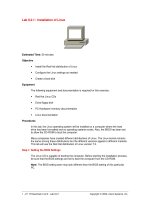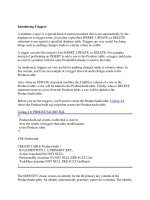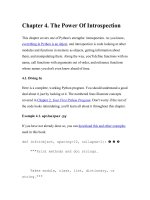Types of Triggers ppt
Bạn đang xem bản rút gọn của tài liệu. Xem và tải ngay bản đầy đủ của tài liệu tại đây (51.97 KB, 11 trang )
Types of Triggers
AFTER Triggers
After triggers are executed after the action of the INSERT, UPDATE, or DELETE
statement is performed. Specifying AFTER is the same as specifying FOR, which is the
only option available in earlier versions of SQL Server. AFTER triggers can be specified
only on tables.
INSTEAD OF Triggers
INSTEAD OF triggers are executed in place of the usual triggering action. INSTEAD OF
triggers can also be defined on views with one or more base tables, where they can
extend the types of updates a view can support.
INSTEAD OF triggers give you the ability to evaluate the changes that would have taken
place if the data modification statement had actually executed. Like AFTER triggers,
each INSTEAD OF trigger gives you access to two virtual tables called Inserted and
Deleted. For a DELETE trigger, the virtual table Deleted holds all the deleted rows, and
for an INSERT trigger, the virtual table Inserted holds all the new rows. (For INSTEAD
OF triggers, the Deleted table holds the rows that would have been deleted and the
Inserted table holds the rows that would have been inserted had the modification taken
place.) An UPDATE trigger populates both the Inserted and Deleted tables; the Deleted
table stores the old version of the rows, and the Inserted table stores the new version.
With all triggers, the Inserted and Deleted tables change their structure to reflect the
columns and data types of the table the trigger is attached to. For example, if you have a
trigger on the Titles table in the Pubs database, the Inserted and Deleted tables will have
the same columns as the Titles table with the same names and data types.
Table 11.1 compares an INSTEAD OF trigger with an AFTER trigger. Following is a
simple example. Suppose you want to make sure that when someone updates any prices
in the Titles table in the Pubs database, the change is no more than 10 percent of the
original price. You need to look at both the old price value and the new value to see
whether the change is more than 10 percent. You can get the old value from the Deleted
table and the new value from Inserted. You must also make sure that the primary key
title_id doesn't change so that you can use that key to relate rows in Deleted to the
corresponding rows in Inserted.
T-SQL Code 1 contains the AFTER trigger that performs the price check. In SQL Server
2000, you can use the word AFTER instead of FOR; the meaning is equivalent. If your
application includes both kinds of triggers, you might use the word AFTER for
consistency and to clearly distinguish the two kinds of triggers. And triggers you created
with the word FOR in previous SQL Server releases will still work. Because the AFTER
trigger fires after a client updates the Titles table, the trigger must force a rollback if it
encounters an error. If no ROLLBACK TRANSACTION occurs, SQL Server has
accepted the change and lets it persist.
Table 11.1. Comparison of AFTER and INSTEAD OF triggers
Function AFTER trigger INSTEAD OF trigger
Applicability Tables Tables and views
Quantity per table or view Multiple per triggering
action (UPDATE,
DELETE, and INSERT)
One per triggering action
(UPDATE, DELETE, and
INSERT)
Cascading references No restrictions apply Not allowed on tables that are
targets of cascaded referential
integrity constraints.
Execution
After:
Constraint processing
Declarative referential
actions
Inserted and deleted tables
creation
Triggering action
Before:
Constraint processing
In place of:
After:
The triggering action inserted
and deleted tables creation
Order of execution First and last execution
may be specified
Not applicable
text, ntext, and image
column references in inserted
and deleted tables
Not allowed Allowed
CREATE TRIGGER AFTER_UPDATE_TITLES
ON titles
FOR update
AS
We will assume that more than one row could have been updated.
The inserted and deleted tables will have to be joined on their
primary key, so we can't allow changes to the primary key.
IF @@rowcount = 0 RETURN
IF UPDATE(title_id) BEGIN
PRINT 'updates to primary key title_id are not allowed'
ROLLBACK TRAN
RETURN
END
IF UPDATE (price)
IF (SELECT MAX(ABS((i.price - d.price)*100/d.price))
FROM inserted i JOIN deleted d
ON i.title_id = d.title_id) > 10
BEGIN
PRINT 'Price Change not allowed'
ROLLBACK TRAN
RETURN
END
GO
Now look at the INSTEAD OF trigger that T-SQL Code 2 shows. This trigger fires
before the changes happen, but the rows that would have been affected are available in
the Inserted and Deleted tables. The basic comparison for price changes greater than 10
percent is the same in this trigger as in the AFTER trigger.
CREATE TRIGGER INSTEAD_OF_UPDATE_TITLES
ON titles
INSTEAD OF update
AS
IF @@rowcount = 0 RETURN
IF UPDATE(title_id) BEGIN
PRINT 'updates to primary key title_id are not allowed'
RETURN
END
IF UPDATE (price)
BEGIN
IF (SELECT MAX(ABS((i.price - d.price)*100/d.price))
FROM inserted i JOIN deleted d
ON i.title_id = d.title_id) > 10
BEGIN
PRINT 'Too big of a price change'
RETURN
END
Because the update passed the tests, we have to
actually do the update; this section updates only
the price field; if other columns also changed,
we would have to account for them.
UPDATE t
SET price = i.price
FROM titles t join inserted i
ON i.title_id = t.title_id
WHERE t.title_id = i.title_id
END
RETURN
The most difficult aspect of using the INSTEAD OF trigger is determining what to have
SQL Server do if it deems the update acceptable. If you want to carry out the intended
update, you could delete all the rows that match the rows in the Deleted table and insert
all the rows from the Inserted table. But in this case, the Titles table has foreign-key
references from other tables, so you can't delete rows from Titles. My simple solution,
which the T-SQL Code 2 shows, works on the premise that the price was updated, so the
trigger can update the price values in the Titles table based on the Inserted table's
contents. If the original UPDATE had set many columns to new values, this trigger
would be more difficult to write.
Both AFTER and INSTEAD OF triggers prevent updates to the primary key of the Titles
table, and both triggers prevent updates to the price column that would change the price
by more than 10 percent. Of course, you probably wouldn't have both these triggers on
the Titles table; you would choose to have one or the other because you need to validate
the price change only once.
Core Difference Between INSTEAD OF and AFTER Triggers
Besides using the words INSTEAD OF in place of FOR or AFTER, INSTEAD OF
triggers behave differently from AFTER triggers. For example, you can have only one
INSTEAD OF trigger on each table for each action (INSERT, UPDATE, and DELETE),
and you can't set a firing order for INSTEAD OF triggers. (In SQL Server 2000, you can
specify which AFTER trigger should execute first and which should execute last.)
Also, you can't combine INSTEAD OF triggers and foreign keys with CASCADE on a
table. For example, if the Sales table has a foreign-key constraint that references the
Titles table and specifies CASCADE as the response to DELETE operations on Titles,
you'll get an error message if you try to create an INSTEAD OF trigger for DELETE on
Sales. However, you can have INSTEAD OF triggers for INSERT or UPDATE.
Similarly, if you already have an INSTEAD OF trigger on Sales, you can't alter the table
to add a foreign-key constraint with the CASCADE action for the same data-modification
operation.
Another difference is that INSTEAD OF triggers can never be recursive, regardless of the
setting of the Recursive Triggers database option. For example, if you execute an
INSTEAD OF trigger for INSERT into Titles and the trigger performs an INSERT into
Titles, the second INSERT won't invoke the INSTEAD OF trigger. Instead, SQL Server
will process the INSERT as if no INSTEAD OF trigger existed for INSERT, and any
constraints and AFTER triggers will take effect.
Although you might think INSTEAD OF triggers and AFTER triggers could be
interchangeable in some situations, the purpose and the real power of INSTEAD OF
triggers is to let you update a certain class of views that aren't usually updatable. In fact,
you can't create an AFTER trigger on a view, but you can create an INSTEAD OF
trigger. For example, you usually can't execute DELETE operations on a view that is
based on a join. However, you can write an INSTEAD OF DELETE trigger. The trigger
has access (through the Deleted table) to the rows of the view that would have been
deleted had the view been a real table. Similarly, in an INSTEAD OF UPDATE or
INSTEAD OF INSERT trigger, you can access the new rows through the Inserted table.
Which Trigger to Pick?
The AFTER trigger might appear less efficient because it sometimes needs to undo work
that has already been done. If you think your table will have numerous violations that
your trigger will need to correct, you might want to choose the INSTEAD OF trigger.
However, if the vast majority of your updates will be acceptable, the INSTEAD OF
trigger will have more work to do and thus be less efficient. In the case of AFTER
triggers, the contents of the Inserted and Deleted tables are directly available from the
transaction log. By the time the AFTER trigger executes, the data modification has
happened, SQL Server has logged the changes, and the changed records are available
internally to SQL Server. In fact, when you use AFTER triggers, you can think of the
Inserted and Deleted tables as views of the transaction log.
When INSTEAD OF triggers fire, SQL Server hasn't yet made any changes and
consequently hasn't logged any changes. SQL Server builds worktables to hold the
inserted and deleted records as if the modification had occurred. Then, if the modification
takes place, SQL Server must make the changes and log them, adding to the work of
creating the worktables. Besides the extra work, another reason INSTEAD OF triggers
are the less desirable type has to do with updates, such as those in the price-changing
example. If many of the table's columns could be included in the SET clause in the
UPDATE statement, the trigger would be cumbersome to write, and each column would
have to be checked to see whether it had a different value in the Deleted or Inserted
tables.
Designing INSTEAD OF Triggers
The primary advantage of INSTEAD OF triggers is that they allow views that would not
be updatable to support updates. A view comprising multiple base tables must use an
INSTEAD OF trigger to support inserts, updates, and deletes that reference data in the
tables. Another advantage of INSTEAD OF triggers is that they allow you to code logic
that can reject parts of a batch while allowing other parts of a batch succeed.
An INSTEAD OF trigger can take actions such as ignoring parts of a batch, not
processing a part of a batch and logging the problem rows, and taking an alternative
action if an error condition is encountered. (
Note: INSTEAD OF DELETE and
INSTEAD OF UPDATE triggers cannot be defined on a table that has a foreign key
defined with a DELETE or UPDATE action.) Coding logic as part of an INSTEAD OF
trigger prevents all applications accessing the data from having to reimplement the logic.
In the following sequence of Transact-SQL statements, an INSTEAD OF trigger updates
two base tables from a view. In addition, two approaches to handling errors are shown.
(1) Duplicate inserts to the Person table are ignored, and the information from the insert
is logged in the PersonDuplicates table. (2) Inserts of duplicates to the EmployeeTable
are turned into an UPDATE statement that retrieves the current information into the
EmployeeTable without generating a duplicate key violation.
The Transact-SQL statements create two base tables, a view, a table to record errors, and
the INSTEAD OF trigger on the view. These tables separate personal and business data
and are the base tables for the view.
CREATE TABLE Person
(
SSN char(11) PRIMARY KEY,
Name nvarchar(100),
Address nvarchar(100),
Birthdate datetime
)
GO
CREATE TABLE EmployeeTable
(
EmployeeID int PRIMARY KEY,
SSN char(11) UNIQUE,
Department nvarchar(10),
Salary money,
CONSTRAINT FKEmpPer FOREIGN KEY (SSN)
REFERENCES Person (SSN)
)
This view reports all relevant data from the two tables for a person:
CREATE VIEW Employee AS
SELECT P.SSN as SSN, Name, Address,
Birthdate, EmployeeID, Department, Salary
FROM Person P, EmployeeTable E
WHERE P.SSN = E.SSN
You can record attempts to insert rows with duplicate social security numbers. The
PersonDuplicates table logs the inserted values, the name of the user who attempted the
insert, and the time of the insert.
CREATE TABLE PersonDuplicates
(
SSN char(11),
Name nvarchar(100),
Address nvarchar(100),
Birthdate datetime,
InsertSNAME nchar(100),
WhenInserted datetime
)
The INSTEAD OF trigger inserts rows into multiple base tables from a single view.
Attempts to insert rows with duplicate social security numbers are recorded in the
PersonDuplicates table. Duplicate rows in the Employee Table are changed to update
statements.
CREATE TRIGGER IO_Trig_INS_Employee ON Employee
INSTEAD OF INSERT
AS
BEGIN
SET NOCOUNT ON
Check for duplicate Person. If no duplicate, do an insert.
IF (NOT EXISTS (SELECT P.SSN
FROM Person P, inserted I
WHERE P.SSN = I.SSN))
INSERT INTO Person
SELECT SSN,Name,Address,Birthdate,Comment
FROM inserted
ELSE
Log attempt to insert duplicate Person row in PersonDuplicates
table.
INSERT INTO PersonDuplicates
SELECT SSN,Name,Address,Birthdate,SUSER_SNAME(),GETDATE()
FROM inserted
Check for duplicate Employee. If no duplicate, do an insert.
IF (NOT EXISTS (SELECT E.SSN
FROM EmployeeTable E, inserted
WHERE E.SSN = inserted.SSN))
INSERT INTO EmployeeTable
SELECT EmployeeID,SSN, Department, Salary,Comment
FROM inserted
ELSE
If duplicate, change to UPDATE so that there will not
be a duplicate key violation error.
UPDATE EmployeeTable
SET EmployeeID = I.EmployeeID,
Department = I.Department,
Salary = I.Salary,
Comment = I.Comment
FROM EmployeeTable E, inserted I
WHERE E.SSN = I.SSN
END
Summary
In this chapter we covered the topic of indexed views and the advantages of using them
and the differences between the indexed views and the traditional AFTER views.
Triggers
The constraints we've discussed to this point?NOT NULL, CHECK, FOREIGN KEY,
PRIMARY KEY, and UNIQUE?are known as
declarative constraints. Triggers are not
declarative because they contain procedural code. They're slightly less pure in the
relational sense, and early DBMSs didn't support them, but today seven of the Big Eight
support both declarative constraints and triggers.
Portability
The exception is MySQL, which supports only PRIMARY KEY and UNIQUE as
declarative constraints, and doesn't support triggers at all. The gains shown throughout
this section are for only seven DBMSs.
In our tests, we found that triggers are slower than declarative constraints. For example,
firing this trigger with a compound SQL statement:
CREATE TRIGGER Trigger1
AFTER INSERT ON Table1
REFERENCING NEW ROW AS New
FOR EACH ROW
BEGIN
IF
New.column1 NOT BETWEEN 1 AND 10
THEN
SIGNAL SQLSTATE = '23000'
END IF
END
is slower than leaving the checking up to the CHECK constraint in this table definition:
CREATE TABLE Table1 (
column1 SMALLINT,
CHECK (column1 BETWEEN 1 AND 10)
)
GAIN: 4/7
Portability
Because triggers were around long before the SQL Standard got around to requiring
them, every DBMS uses slightly different syntax to define triggers. A discussion of the
differences is beyond the scope of this book.
However, before glibly saying "declarative constraints are better than triggers," we
should note that the trigger has flexibilities that might be more important to you than
performance. For example, a trigger statement can log an incident and return a
customized warning, while all a declarative constraint can do in the same instance is
return an error with a fixed error message. An old saw, which we've never heard before,
goes?The more inflexible the server is, the more adaptable the client must be.
Nevertheless, the trigger involves so many steps that it can't be fast. Consider the steps
shown in
Listing 10-3.
Listing 10-3 Steps involved in executing a trigger
A trigger must:
Make a savepoint.
For each row: {
Perform "before each row" trigger code.
Copy the row as it exists before update, to a BEFORE IMAGE.
Update the row.
Copy the row as it exists after update, to an AFTER IMAGE.
}
At end of statement (after constraints are checked): {
For each row: {
Perform "after each row" trigger code.
If (fatal error) restore to savepoint.
}
Cleanup.
}
Listing 10-3 shows that a trigger does two "for each row" loops. In theory the DBMS
doesn't have to do the second loop if the trigger is only "before each row." In practice,
though, before- and after-triggers are equally fast.
At this time, there is support only for INSERT, UPDATE, and DELETE triggers (except
with Informix, which also provides SELECT triggers). To make a SELECT trigger, you
can employ a trick that works like this?Suppose you want to keep a log of each time that
a row from
Table1, which contains the string WASHINGTON in a column named city, is
retrieved. The solution is to mandate that all selections must go via a view of
Table1,
called
View1, and to define View1 with an external function call. The SELECT statement
would thus look like this:
SELECT * FROM View1
WHERE city = 'WASHINGTON'
The CREATE VIEW statement would look like this:
CREATE VIEW View1 AS SELECT
Table1.*,
Function1(city) AS Function_return
FROM Table1
And the CREATE FUNCTION statement would look like this:
CREATE FUNCTION Function1
(parameter1 CHAR(10)) RETURNS SMALLINT
LANGUAGE C
PARAMETER STYLE GENERAL
NOT DETERMINISTIC
RETURN NULL ON NULL INPUT
NO SQL
EXTERNAL
Finally, the external function code would look like Listing 10-4.
Listing 10-4 External function code for SELECT trigger
short* __export __cdecl FUNCTION1 (char* c)
{
static short return_value;
HANDLE FileHandle;
HANDLE MutexHandle;
unsigned long ret;
if (lstrcmp(c,"Washington")==0) {
MutexHandle=CreateMutex(0,TRUE,"MUTEX");
FileHandle=CreateFile(
"T",
GENERIC_WRITE,
0,
0,
OPEN_ALWAYS,
FILE_ATTRIBUTE_NORMAL,
0);
SetFilePointer(FileHandle,0,0,FILE_END);
WriteFile(FileHandle,"it happened",11,&ret,0);
CloseHandle(FileHandle);
CloseHandle(MutexHandle);
return_value=ret; }
else return_value=0;
return (&return_value); }
The matter is not simple?you must persuade the DBMS that the function is unpredictable
and can change the column value. Otherwise, the DBMS will optimize the function call
and only do it once. To persuade the DBMS not to optimize, write the function in a
language the DBMS doesn't understand natively, make the column input/output (in fact
the column isn't touched), and above all declare the function as NOT DETERMINISTIC.
A word of caution about NOT DETERMINISTIC functions. In real triggers, it is possible
to call stored procedures with nondeterministic functions, but there is a peril. Our favorite
one triggers an action that depends on the time of day, because "for some reason" time of
day can't be used in a CHECK clause. Well, some people would think that reason is
important?suppose the database becomes corrupt, and the recovery procedure involves
rerunning a log of transactions. In such a case, the recovery isn't run at the same time of
day as the original transaction?and thus a transaction that succeeded before the crash will
fail during the recovery. Remember that some DBMSs handle functions in select lists
when they open the cursor; others handle them when they fetch from the cursor.
The Bottom Line: Triggers
If speed is your only concern, use declarative constraints instead of triggers.
Use views with an external function call to write a SELECT trigger.
Declarative constraints differ from triggers in that constraint conditions guarantee that
data always fulfills a specific requirement, while trigger conditions are enforced only
when data changes. That is, constraints are passive requirements for correctness, while
triggers are responses only to specific actions.
Because trigger checking happens after constraint checking, it's tricky to change the value
of a table column within the trigger. That could lead to loops (because the change would
cause another constraint check) or to subversions (because the change wouldn't go
through the same checking that a regular data-change statement would go through). The
SQL Standard has special rules that are designed to prevent such tricks.
Triggers fire on INSERT, UPDATE, or DELETE statements but not on "implied" inserts
like the DBMS's nonstandard database LOAD statement and not on "implied" deletes like
the DBMS's nonstandard table TRUNCATE statement.









